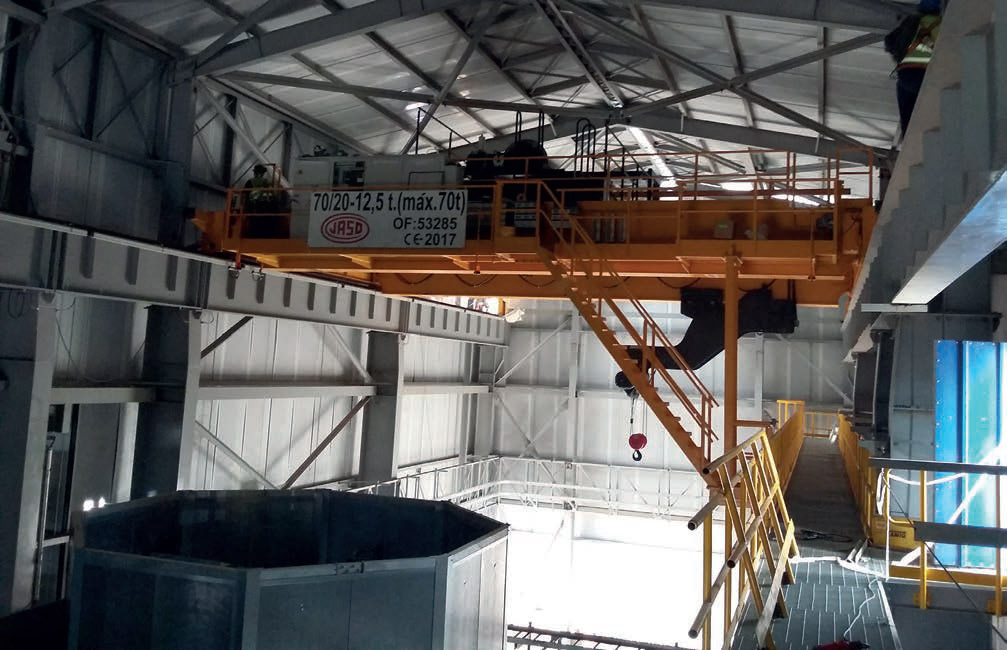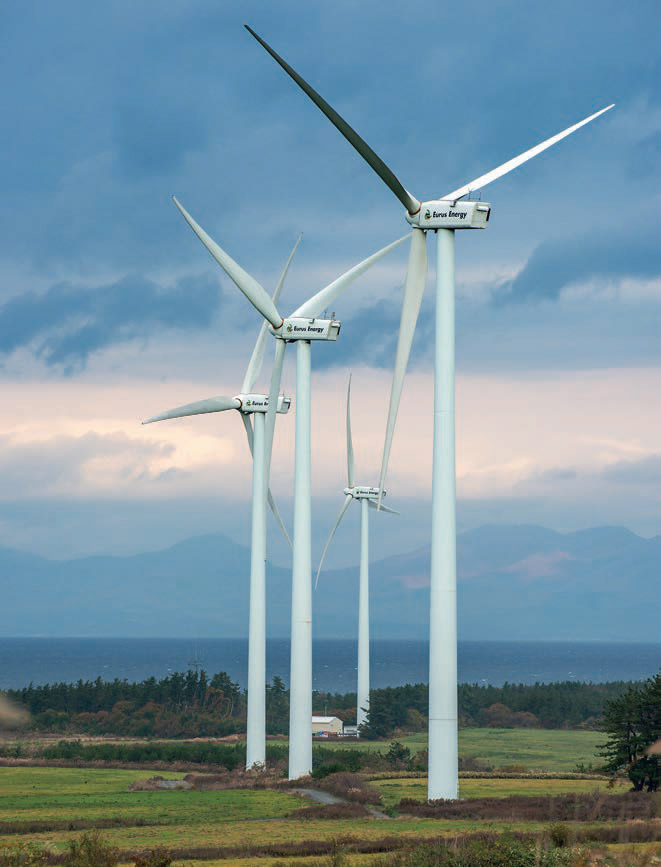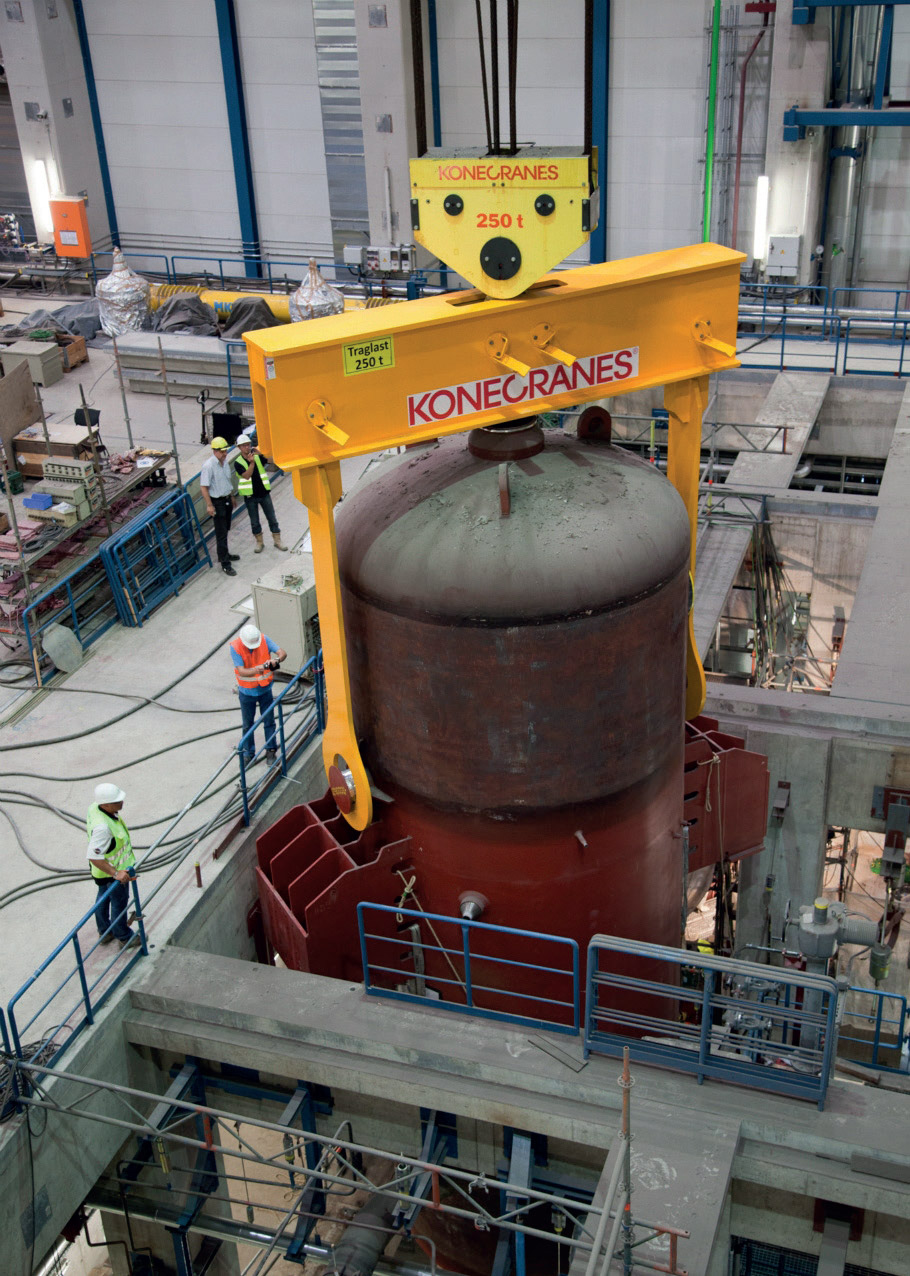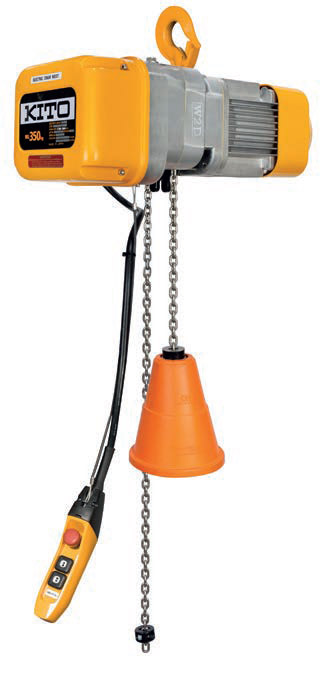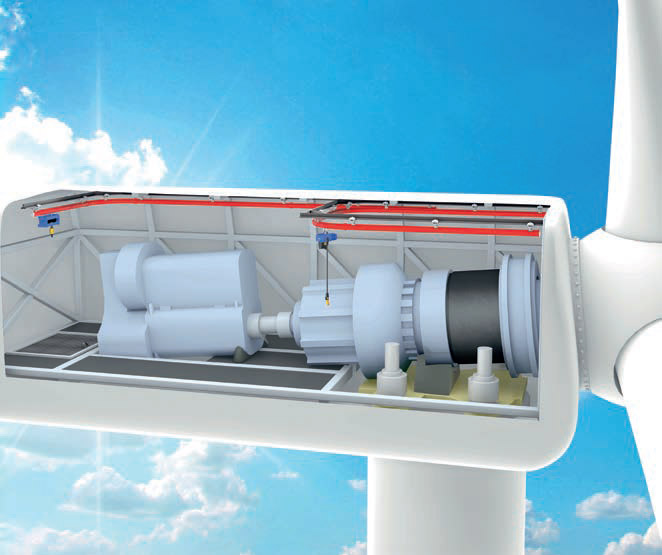Renewed Interest
28 August 2020Energy production used to mean coal, oil and gas, with nuclear as an adjunct. Not any more: alternative sources are set to overtake fossil fuels, and the lifting equipment they will need is as varied as the sources. Julian Champkin reports.
Power generation seems a simple sector to define but it covers a huge spread of technologies, each with different requirements from its lifting apparatus. Traditional coal-mining needs hoists that can work in confined and dust-filled conditions underground; available space in wind-farm nacelles is also narrow and confined but can be a hundred metres or more above the surface, and sea spray rather than dust is the environmental hazard, at least in offshore installations.
Hoists to maintain hydro turbines may be called upon only a few times a year, standing idle between those times for perhaps months at a time. Thermal plants, in contrast, whether powered by coal, or by biomass or household refuse in waste-to-energy plants, have steam generators that need to be fed with fuel, generally by a process crane which is required to operate continuously 24/7, and 365 days a year if possible.
Solar panels are a booming renewable source but need very little in the way of lifting apparatus and even less of that is specialised or high-capacity. Nuclear on the other hand needs sometimes very high lifting capacity indeed and is so specialised that it is in effect a world of its own.
So capacities in the power industry can range from the minimal to the very large; cycle-ratings from continuous 24/7 to one or two usages a year; and working environments from ultra-hazardous to clean and easy. Maintenance lifting requirements are different from needs during construction. Which is one reason hoist manufacturers stress the wide range of their products for the power industry.
“Electric, pneumatic and hydraulicallyoperated winches are all used in the power industry,” says Gus Caldera, head of product management at Ingersoll Rand; “and remote control is a recent development that the sector is wanting. We can supply remote control for all three power sources, and that is unique.”
Konecranes says: “The needs of the power industry range from manual winches up to accurate lifts of heavy and valuable equipment like turbines, generators and nuclear fuel.” Some factors, though, are universal: “The power industry depends on safe and reliable equipment,” the company continues, “and on familiarity with legislation, regulations and standards.” Konecranes, the company says, supplies all of these.
Pandemic Impact
Covid-19 has caused an unprecedented reduction in energy use worldwide; but no matter what the world looks like and what form working practices take afterwards, it is a fair bet that demand for some forms of energy will, post-Covid, continue to rise. Others will take longer to recover or perhaps be permanently affected.
“It’s no surprise that oil and gas are depressed right now,” says Caldera. “They will stay that way until oil inventories drop; but we expect to see recovery by the end of the year. The big change, though, is in renewables. A recent study from Shell predicts that by 2022 investment in wind power will be as great as, or greater than, investment in oil and gas. So that will be massive. France, for example, will see a lot of investment over the next two years; India even is investing in wind power to replace oil and gas. The US has a lot of catch-up to do.
“And the overview from Shell is that oil and gas will hit peak sometime between 2030 and 2040. Other power streams are coming on-stream in a very major way— solar in particular.”
In its second-quarter earnings report published on July 24, Konecranes said that the worldwide demand picture remains subject to significant volatility due to the Covid-19 pandemic. The current demand environment within the industrial customer segments is showing signs of improvement in Europe and North America compared to Q2, yet remains below the year-end 2019 level. At the moment, the demand environment in Europe is overall less volatile compared to North America. While China’s demand conditions have improved from early 2020, demand environment in the rest of Asia-Pacific is weak.
Antonio Naranjo, marketing manager at Spain-based Jaso, says: “The crisis caused by Covid-19 is hitting the entire economy, although with different intensities depending on sectors. At this stage, the renewable energy and waste management sectors have held up well. There is support for heavy investments in these sectors for permanent renewal of machinery and through very attractive new projects.
“At Jaso we are noticing that Europe is the first continent that is being reactivated.
Conversely, we have noticed a slowdown in large investments in South America and the Middle East, not only due to the Covid-19 crisis but also the oil and gas crisis.”
Tsuyoshi Oshita, senior manager of corporate communications at Kito, says: “The impact of Covid-19 has extended to all regions and industries. In the natural resources sector demand for gasoline and jet fuel has fallen sharply, and is expected to stagnate over the long term. As crude oil prices have fallen, we foresee weak capital investment in those industries for a while.” Markus Otto at Demag: “But power is always needed, so there will still be demand for it post-Corona, from one source or another.”
And oil is not the only energy: “There is still demand for maintenance at mining sites and petrochemical plants,” says Oshita, “but diversification of energy sources will remain the key issue, and investment in clean energy sectors such as wind power generation will continue.” For that, he says, Kito is well placed and focused: “Kito offers customised electric hoist products such as explosion proof lifting gear for resource and petrochemical plants. For wind power generation, we provide hoists with high speed and rust prevention specifications.”
All these sources of power have one thing in common: they all produce electricity, and that electricity has to be conveyed to the customer. Overhead power lines may seem unglamorous, but are an essential part of the whole industry; neglecting them can have disastrous consequences, as California power company PG&E has found to its cost, having been found liable for $13.5bn of damages caused by forest fires ingited by poorly-maintained power lines. So it is not inappropriate to mention here the manual hand chain hoists such as Kito’s LB lever hoist series, whose marketing expressly includes construction and maintenance of power lines as one of their particular uses.
Wind Power
“There is increasing demand from makers of wind turbines; we sell to manufacturers of rotor blades and nacelles, and also hoists for maintenance of wind turbines once they are erected” says Otto of Demag.
“The nacelle of a wind generator tower is a tough environment, especially when the tower is offshore,” he says. “It is, obviously, windy, and corrosive with salt spray; and space inside it is restricted and confined— even more so in onshore installations.
Nevertheless the need is to lift tools and equipment for maintenance and repair up from ground level, which can be 100m or more on land-based towers and much more on offshore ones; and once they are up there the heavier items, such as motors and gearboxes, need to be manoeuvred around inside the nacelle. So you need an intralogistics solution: the hoist lifts the load a great distance from the ground, then moves inside the nacelle on rails— which can have junctions—to position the load. They are generally controlled by an operator inside the nacelle. Our KBK hoist system is ideal for that.
“Years ago, when the sector was still new, turbines were smaller and chain hoists were used. With increasing height, wire rope hoists were developed for the purpose, as a lot more efficient—you are not lifting all that weight of chain—and economical. They are also very much faster. Our basic DS10 product has been refined and developed over the past decade especially for wind turbines: they have multilayer technology to give three layers of rope on the drum for the high lifting; they lift up to 180m; and they are robust and corrosion-proof for offshore use as well.”
Caldera at Ingersoll Rand: “Perhaps surprisingly, only a limited amount of energy is available to power a winch on the top of a wind tower. A back-up system bleeds power from the generator side to its own service panel, and on some sites a limited amount can be fed as emergency back-up through a cable up the inside of the tower; but even while it is generating for the grid, the useable amount of electricity up there is very small.
“Yet the need is for a winch that can lift a half-ton load 100m or more. Capacities can go higher: 1t capacity is the largest I have seen. Wind turbine makers are settling on a single standard with a spare motor. It is becoming a mature market. We are doing a lot of work there; a lot more of them are being installed.”
Oshita at Kito says: “Kito hoists for the wind industry are designed to meet various certifications like JIS, ISO, EN, UL/CSA, CE, and so forth. Many of our hoists wind generators are installed as high as 100m or more above ground. For that purpose the chain must wind out at very high speed to ensure work efficiency, and gear parts are strictly made to fit that need.
The hoists built to wind industry specs are also designed for higher rust resistance and dust containment to ensure safety and good operation even in case of low frequency use. And the chain container is specially designed to prevent long load chain from being twisted or entangled.” Kito has delivered more than 100 units of its ER electric hoists to the Nobechi wind farm in Japan. They have also a customised solution, based on the Kito ER2 industrial hoist.
Jaso, too, is serving the wind sector. “We have extensive experience working in collaboration with wind power companies and we are the leading supplier for this sector in Spain,” says Naranjo, “and we are responding to the needs of international wind power companies, working with providers such as Haizea wind, Siemens- Gamesa and Acciona.”
Digital technology is also integral to this sector, he adds: “Jaso’s Smartlink is a technological solution that provides operational data that can be seen in real time, which helps reduce operational risks, improves monitoring of crane maintenance and avoid unexpected stops.
This technology fits perfectly with the current needs of wind power sector, where the industrial revolution 4.0 is radically changing things. The integration of our Cranebot robotics technology in wind power is adding a layer of automation that is even more innovative.”
Hydropower
Hydropower is a much longer-established technology than wind, and has demands of its own. “Demag supplies winches for the maintenance of turbines in Siemens powerhouses,” says Otto. “Powerhouse winches may be buried deep within a concrete hydro dam; replacing them would be a very major operation, so the expectation is that they will last the lifetime of the dam. Even so, lifetimes of hoists and winches depend on the amount of work it is called upon to do—the number of cycles— and in a turbine hall the usage will be low, so long lifetimes are possible; but what is essential is that the hoist should work when it is required, even after months or years of being inactive.
“Powerhouse winches need high capacities—turbines are heavy and sensitive pieces of equipment—and are sited in halls with small headroom and narrow spaces. So the overview is of a compact design of trolley. Capacities are of 450t, even 500t, and hoists have the latest in sensitive load movement and control technology—turbines are delicate things. In powerhouses control will generally be remote, though manual is possible.”
Thermal Renewables
On 28th April this year the UK broke a record that has stood for 138 years: it celebrated 18 consecutive days in which coal-fired power plants did not contribute to the national electricity grid. The last time this had happened was in 1882. Nuclear and renewables supplied all our power needs. It was of course helped by the huge reduction in energy demand that has followed the Covid-19 pandemic; even so, it is an indicator of things to come. The UK’s largest thermal power station, the 3.9Mw Drax station in north Yorkshire, built as a coal-fired station, now has four of its six units burning woodchip instead, with plans to stop burning coal altogether by early 2021.
Other fuels for thermal plants include biomass and household refuse, burned in waste-to-energy plants. “In all of these, the furnaces are fed by some sort of bulk grabbing cranes,” says Demag’s Otto. The requirements are the opposite of hydro turbine hall cranes: “Non-stop production is needed the whole year round. So they are in full-time use, 24/7, in continuous operation with pauses for maintenance kept to the minimum possible. So reliability and performance are major issues, and so too is economy. In a turbine-hall crane that is used twice a year it does not matter too much if it is a little heavy on fuel; for a process crane that is in use all the time, fuel-efficiency is a major issue.”
Because the same operation is repeated time and again—moving fuel from bunker to hopper, from bunker to hopper, from bunker to hopper—the application is ripe for automation. “The tendency is towards full automation,” says Otto. “The more frequently and heavily a crane is used, the more automation makes a lot of sense.
“Customers are specifically looking for these things: reliability, efficiency, economy. Ideally they do not want to think about their crane at all once it is installed—they want it to be just a tool that is always there and working away for them. But in Europe, many waste-to-energy plants are now 20 to 40 years old, and therefore ready for refurbishment or upgrading. The decision for operators is therefore whether to upgrade their existing crane with modern automation and controls, or to replace it altogether. That second option often makes more sense. Steel after 40 years may be ending its lifetime; and it is very much quicker to replace a crane than to refurbish one. There is much less on-site work involved. You just whip out the old one and put in the new one, off the shelf perhaps, and you are back at work straight away.
“Added to which your new crane will be smoother and more economical. Technology has advanced a lot in 40 years. So there is a clear demand for new cranes in existing waste-to-energy plants, especially in central Europe.”
Capacities for these cranes are not necessarily high: the fuels tend to be bulky rather than heavy. An unusual and new sustainable fuel for them, in Germany at least, is sludge—the output of sewerage farms that used to be spread on fields.
“Legislation has recently dis-allowed that; so it is being burned in local energy plants. The plants are usually small scale, so the capacities of the lifting gear does not have to be great.”
The concept of a power plant being built next to a sewerage treatment works may seem strange, but many more changes are on the way. “When the pandemic settles down, we expect that the industry, its working style as well as customer needs will change, and we will see new demands emerging from old and new industries,” says Oshita of Kito. “A broad base in all regions and industries will help to capture them.”
Much has been spoken of the ‘new normal’; in energy, it will look very different from the old.
